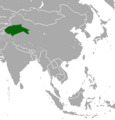Yarkand hare facts for kids
Quick facts for kids Yarkand hare |
|
|---|---|
 |
|
| Drawing, circa 1879 | |
| Conservation status | |
| Scientific classification | |
| Genus: |
Lepus
|
| Species: |
yarkandensis
|
 |
|
| Yarkand hare range | |
The Yarkand hare (Lepus yarkandensis) is a type of mammal that belongs to the Leporidae family, which includes hares and rabbits. This small animal has soft, sandy brown fur on its back with grayish-black stripes. Its belly is completely white.
The Yarkand hare lives only in China, specifically in the Tarim Basin area of Southern Xinjiang. It is mostly active at night, which means it is nocturnal. It searches for food like grass and crops. Female Yarkand hares have two or three groups of babies each year. Each group usually has two to five young hares.
Currently, the Yarkand hare is listed as "near threatened" by the IUCN Red List of Endangered Species. This means it could become endangered soon. Some Chinese scientists believe it is already "endangered" because its home is shrinking and becoming broken up. Also, too much hunting and poaching are problems for these hares.
Contents
Discovering the Yarkand Hare
Who Named the Yarkand Hare?
In 1875, a German zoologist named Albert Karl Ludwig Gotthilf Günther was the first to officially describe the Yarkand hare. He gave it the scientific name Lepus yarkandensis. He published his findings in a science journal called the Annals and Magazine of Natural History.
Later, in 1964 and 1998, other scientists placed this hare in a special group called Tarimolagus. The Yarkand hare does not have any known subspecies, meaning there are no different types of Yarkand hares.
What Does a Yarkand Hare Look Like?
Size and Weight
The Yarkand hare is a small hare. It measures about 28.5 to 43 centimeters (11 to 17 inches) long. It weighs between 1.1 and 1.9 kilograms (2.4 to 4.2 pounds). Its skull is also small, measuring about 7.6 to 8.8 centimeters (3 to 3.5 inches) long.
Fur and Features
This hare has soft, straight, sandy brown fur on its back. This fur often has grayish-black stripes. The fur on its belly is completely white. Its ears are long, about 9 to 11 centimeters (3.5 to 4.3 inches) long. Unlike some other hares, the tips of its ears do not have black markings.
In winter, the hare's fur becomes lighter. It turns a light sandy brown color on top. Its tail is about 5.5 to 8.6 centimeters (2.2 to 3.4 inches) long. The tail is smoke gray on top and whitish or creamy yellowish-white underneath. Its front feet are very pale brown, and its hind feet are also pale brown. The hind feet measure about 9 to 11 centimeters (3.5 to 4.3 inches) long.
How to Tell it Apart from Other Hares
The Yarkand hare can be told apart from the desert hare (Lepus tibetanus). The desert hare has black near the tips of its ears, but the Yarkand hare does not. It is also different from another hare, Lepus oiostolus pallipes, because it does not have gray fur on its rump (rear end). The Yarkand hare is also smaller and has thinner legs than both the desert hare and Lepus oiostolus pallipes.
It is easy to tell the Yarkand hare apart from other hares in China. For example, it has longer ears than the Chinese hare (Lepus sinensis).
Where Do Yarkand Hares Live?
Their Home in China
The Yarkand hare lives only in China. It is found in the Tarim Basin area of Southern Xinjiang. Its home range is between 36° N and 42° N latitudes and 76° E and 92° E longitudes.
Preferred Habitat
These hares like to live in basins and desert areas. They prefer places with plants like Chinese tamarisk (Tamarix chinensis), bushes, or poplar trees (Populus). They are often found along the edges of rivers that surround the mountains in the Taklamakan Desert. This creates a ring-shaped area where they live. They also use tall reed plants near rivers for shelter. They tend to stay away from farm fields.
Scientists believe that about 200,000 Yarkand hares live in the Tarim Basin. However, in 2010, a scientist named Y.H. Wu from the Chinese Academy of Sciences said that the species is "endangered." This is mainly because their habitat is broken up into small, isolated areas. Professor Wu explained that the Yarkand hare lives in scattered oases, which are like islands of green land separated by desert. This makes it a good animal to study how breaking up habitats affects animal populations.
Behavior and Life Cycle
Daily Activities
The Yarkand hare is mostly nocturnal. This means it is active mainly in the early morning or late evening. Sometimes, it also feeds during the night. During the day, it hides in small dips in the ground or under plants to stay safe.
When it looks for food, the hare eats grass and crops. It often uses the same paths to find food, which can be 1 to 2 kilometers (0.6 to 1.2 miles) long.
Reproduction
The breeding season for Yarkand hares starts in February. It can last for seven or eight months, until September. Female hares usually have two or three litters (groups of babies) each year. Each litter has about two to five young hares.
While we don't know much about how far they travel in their daily lives, it was once thought that many hares lived in a small area. In 1983, a researcher named Gao reported that four people could find 20 or more Yarkand hares in just three hours of watching them in the wild.
Predators
The main animal that hunts the Yarkand hare is the eagle.
Status and Conservation Efforts
Current Status
Since 1996, the Yarkand hare has been listed as a "near threatened" species on the IUCN Red List of Endangered Species. This is because it lives in a limited area. Even though it is found throughout its distribution, its population is decreasing by about 30%. This decline means it is almost at the level of being considered "vulnerable."
Threats to the Yarkand Hare
The Yarkand hare is hunted for sport. Between 1958 and 1981, about 10,000 hare furs were produced each year. Human activities, like building roads and exploring for oil, have also caused the hare's population to drop.
The Red List of China's Vertebrates also lists the Yarkand hare as "near threatened." It was previously listed as "vulnerable" in its region.
Conservation Areas
The Yarkand hare lives in several nature reserves. These include the Aerjinshan, Luobupoyeluotuo, and Talimuhuyanglin Nature Reserves.
The IUCN report notes that more human activity in the hare's habitat is definitely hurting the species. We don't have exact numbers on how much the population is declining right now. However, it is believed to be a moderate decline, around 30%. This is why it is listed as Near Threatened. The hare lives only in widely spaced oases around the Tarim Basin. This means its habitat is very broken up, as most of the desert has no water or plants. More information is needed about how many Yarkand hares live in these oases. We also need to know if the species is still being poached for food or fur.
The combination of losing its habitat, its habitat being broken into small pieces, and unsustainable hunting are big worries for conservationists. As mentioned before, Chinese researchers believe the Yarkand hare is "endangered."
Images for kids




